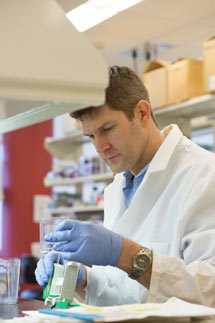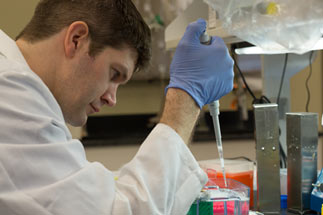UH Scientists Look at How Enzyme Functions Correlate with Disease Progression
 A University of Houston (UH) scientist and his team are working to develop the next
generation of prostate cancer therapies, which are targeted at metabolism.
A University of Houston (UH) scientist and his team are working to develop the next
generation of prostate cancer therapies, which are targeted at metabolism.
With approximately one out of six American men being diagnosed and nearly a quarter of a million new cases expected this year, prostate cancer is the most common malignancy among men in the U.S. Since prostate cancer relies on androgens for growth and survival, androgen ablation therapies are the standard of care for late-stage disease. While patients initially respond favorably to this course of treatment, most experience a relapse within two years, at which time limited treatment options exist.
At this stage, known as castration-resistant prostate cancer, androgen-deprivation therapies are no longer effective, but interestingly, androgen receptor signaling is still active and plays a large role in the progression of the cancer. Because of this, both androgen receptors and the processes downstream of the receptor remain viable targets for therapeutic intervention. Unfortunately, it is unclear which specific downstream processes actually drive the disease and, therefore, what should be targeted.
Daniel Frigo, an assistant professor of biology and biochemistry with the UH Center for Nuclear Receptors and Cell Signaling (CNRCS), has set his sights on a particular cascade of biochemical reactions inside the cell. Focusing specifically on an enzyme known as AMPK, which is considered a master regulator of metabolism, Frigo and his team have demonstrated that androgens have the capacity to take control of this enzyme’s molecular signals.
“The androgen signaling cascade is important for understanding early and late-stage prostate cancer progression,” Frigo said. “We found that when androgens activated this signaling pathway, it hijacked normal conditions, allowing the tumor to use diverse nutrients to the detriment of the patient. These results emphasize the potential utility of developing metabolic-targeted therapies directed toward this signaling cascade for the treatment of prostate cancer, and we look forward to exploring this and other metabolic pathways further in order to develop the next generation of cancer therapies.”
 In their studies, Frigo’s team showed that prostate cancer cells respond to androgens
not only by increasing the breakdown of sugars, a process known as glycolysis that
is commonly seen in many cancers, but also escalating the metabolism of fats. While
much of the research on cancer metabolism has historically focused on glycolysis,
the researchers say it’s now becoming apparent that not all cancers depend solely
on sugars.
In their studies, Frigo’s team showed that prostate cancer cells respond to androgens
not only by increasing the breakdown of sugars, a process known as glycolysis that
is commonly seen in many cancers, but also escalating the metabolism of fats. While
much of the research on cancer metabolism has historically focused on glycolysis,
the researchers say it’s now becoming apparent that not all cancers depend solely
on sugars.
Their findings further indicate that the metabolic changes brought about by the AMPK enzyme result in distinct growth advantages to prostate cancer cells. They say, however, that our understanding of how androgen receptor signaling impacts cellular metabolism and what role this has in disease progression remains incomplete.
The Frigo lab is one of several within the CNRCS concentrated on the role of nuclear receptors in cancer prevention and treatment, and his team has long studied the androgen receptor, which turns on or off various signaling pathways. Frigo believes these pathways hold the potential for better cancer treatments. Targeting these underexplored metabolic pathways for the development of novel therapeutics, Frigo’s ultimate goal is to unlock more effective and less harmful cancer treatment alternatives.
With funding from the Department of Defense, National Institutes of Health, Texas Emerging Technology Fund and Golfers Against Cancer, Frigo’s latest research appears in Nature’s Oncogene. One of the world’s leading cancer journals, Oncogene covers all aspects of the structure and function of genes that have the potential to cause cancer and are often mutated or expressed at high levels in tumor cells.
- Lisa Merkl, University Communication